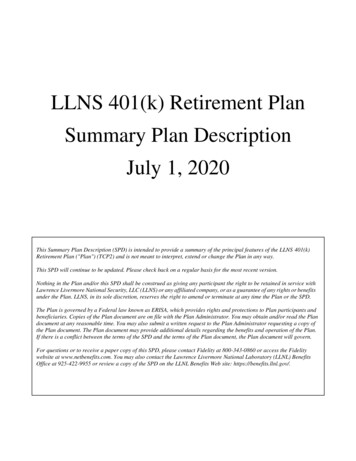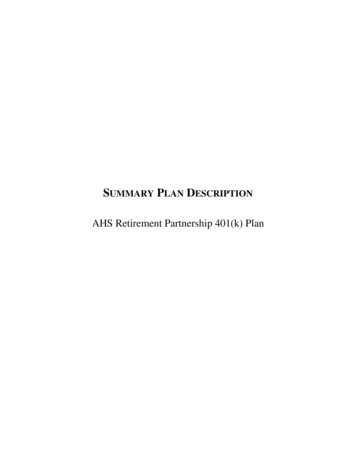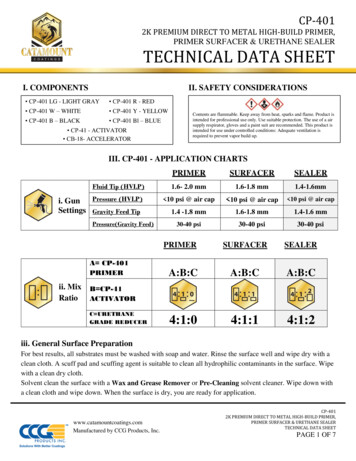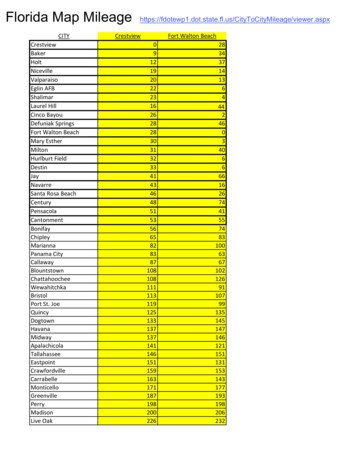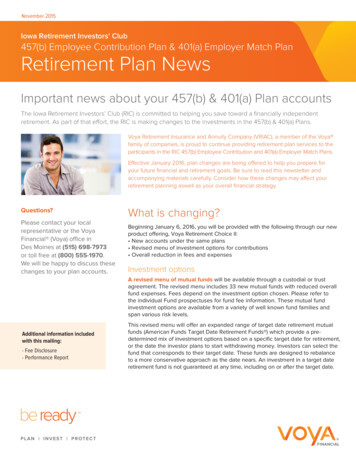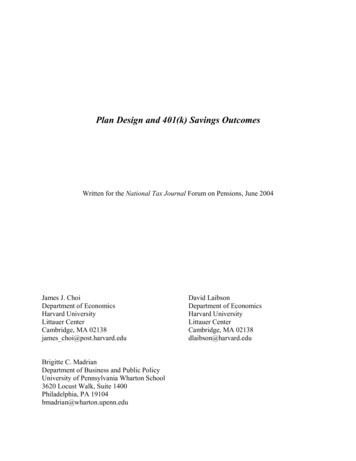
Transcription
SIMPLE Solutionsfor your retirement401(k) BASICSLearn about the benefitsof a 401(k) Plan.
YOUR 401(k) CAN HELP YOU PLANFOR YOUR RETIREMENT.Just how much money are you going to needto maintain your current lifestyle throughoutretirement?Experts suggest that in order to maintain yourlifestyle in retirement, you will likely need 77%to 94% of your final year’s wages for each yearyou are retired.1THE POWER OF STARTING EARLYRetirement income from your 401(k) account,if contributions begin at age 25 or age 45vMonthlyIncome 1,000 1,733 2,083 3,333MonthlyContributions 60 100 125 200Pre-Retirement*Accumulation at age 65Post-Retirement** MonthlyIncome beginning at age 65Beginningat age 25Beginningat age 45Based onage 25Based onage 45 124,255 207,091 258,864 414,183 28,281 47,134 58,918 94,269 771 1,285 1,606 2,569 175 292 365 585*Pre-Retirement example assumes a 6.3% rate of averageannual return. **Post-Retirement example calculations assumea constant 5.75% rate of annual return on unused accountbalances during retirement, and an exhausted account balanceat the end of retirement. It is unlikely that any investmentswould have such consistent returns. The example does notreflect the return of any specific investment and is not intendedto imply or guarantee future results. Retirement income basedon 25 years certain, age 65 through age 90.SAVING FOR RETIREMENTHow can I ever afford to retire? The answer maybe simpler than you think. Participating in youremployer-sponsored 401(k) plan may give youkey tax advantages and the power of compoundinterest to help you reach your retirement goal.2
How a 401(k) Plan Works for You401(k) plans let employees save for retirement ona tax-deferred basis by having contributions to theiremployer-sponsored 401(k) plan deducted directlyfrom their pay before taxes. Although you don’ttypically pay taxes up front on the contributionsyou make to your 401(k) plan, the taxes aregenerally due when you withdraw your savings.As a 401(k) plan participant, your contributions arededucted from every paycheck before taxes. Thismeans you typically only pay federal income taxeson the amount of your income remaining after your401(k) contributions have been deducted by youremployer. This reduces your overall taxable income,which may reduce your federal income taxes.2REDUCTION IN PAID INCOME TAXES 2, 3vAnnual Salary (Gross Income)EMPLOYEE 1NOT CONTRIBUTINGEMPLOYEE 2CONTRIBUTING 35,000 35,000 0 1,050Gross Income Less 401(k)Plan Contributions 35,000 33,950Federal Income Tax4- 4,124- 3,966 0 0 1,050 158401(k) Plan Contributions (3% deferral)( 437.50 plus 15% of amount over 10,425)SummaryTotal Retirement SavingsTotal Reduction in Paid Income TaxThis chart is for illustrative purposes only, and yourcircumstances may differ from this example.With a 401(k) plan you may pay less in taxesand may have more to spend each year!Your 401(k) contributions are placed intothe investment choices5 that you select andaccumulate on a tax-deferred basis until theyare withdrawn.For 2011 employees may be able to defer up to 16,500 per year in a 401(k) plan.
Making Catch-up ContributionsIf you are an employee, aged 50 or over, youmay be able to make additional “catch-upcontributions” each year through an employersponsored plan. For 2011 the catch-upcontribution limit is 5,500. Making the maximumcatch-up contribution every year could addsignificantly to your retirement nest egg.The Saver’s CreditThe Saver’s Credit is a federal governmentincentive to help you save for retirement. If youqualify, the Saver’s Credit may allow you to takea credit of up to 1,000 (up to 2,000 if youfile jointly) if you make eligible contributions to aqualified retirement plan, such as a 401(k) plan.The amount of the credit is determined by yourfiling status, your adjusted gross income, and yourretirement contributions. This tax credit is onlyuseful to tax filers who owe federal income tax,since no refund of excess credit is allowed.To qualify for the Saver’s Credit you must meetthese requirements:2vTO QUALIFY FOR THE “SAVER’S CREDIT” FOR2010 AND 2011, YOU MUST MEET CERTAINREQUIREMENTS: You are age 18 or older You are not a full-time student You cannot be claimed as a dependent on anotherperson’s tax return Your adjusted gross income is at or below:Single filerHead of HouseholdMarried filing jointly2010 27,750 41,625 55,5002011 28,250 42,375 56,500 AND you made eligible contributions to a qualifiedretirement plan, such as a 401(k) plan or an IRA.
SAVER’S CREDIT HELPS YOU SAVE MOREvTAXPAYERS ADJUSTED GROSS INCOME (2010 TAX YEAR)Joint FilerHead ofHousehold 0 - 34,000 0 - 25,500SingleCreditRate 0 - 17,00050% 34,001 - 36,500 25,501 - 27,375 17,001 - 18,25020% 36,501 - 56,500 27,376 - 42,375 18,251 - 28,25010%Over 56,500Over 42,375Over 28,2500%Note: The Saver’s Credit is non-refundable and may only beapplied toward federal income taxes owed in a given year. Ifan individual or household has no tax liability, then the Saver’sCredit would not be treated by the IRS as a refund. For moreinformation, log on to the IRS website at www.irs.gov, or aska tax professional.ACCESSING YOUR RETIREMENTSAVINGSYour 401(k) Savings AvailabilityThe money deducted from your salary to contributeto your 401(k) account may be available to you toaccess,* or you can leave it in the account and letit build your retirement nest egg.2 If your employermakes matching contributions to your 401(k)account, these matching funds may be subject toa vesting schedule. This means that ownership ofthe matching contributions becomes yours overtime with continued service to your employer.Borrowing Against Your 401(k)Your plan may allow you to borrow from your401(k) account.*Like a bank loan, the IRS requires that you payinterest on the money you borrow. However, theinterest is credited back to your account—youpay it to yourself. Repayment of a 401(k) loan maybe deducted right from your pay, making it easyto manage. If your plan allows loans, and you areotherwise eligible to take a loan from your plan, youshould consult with your financial planner or otherqualified professional to determine if such a loan isright for you.*Subject to legal and plan restrictions. See your employer formore details.
Making a Hardship WithdrawalYour 401(k) plan may enable you to accessyour account should you experience a personalhardship. You must have exhausted all othersources of money, including taking a loan fromyour 401(k) account first. Some hardship reasonsmay also apply for immediate family members orprimary beneficiaries, so check with your employer,or www.irs.gov, for current rules and restrictionsthat apply.The hardship must be a qualified “immediateand heavy financial need,” such as one of thefollowing: Excessive medical expenses Purchase of a principal residence Prevention of eviction or foreclosure College tuition To repair damage to a principalresidence due to casualty loss Funeral expensesBefore making a hardship withdrawal, check withyour employer and keep in mind the stringentIRS rules about this type of withdrawal. Still, thisoption may be available to you.A hardship withdrawal is a distribution, so taxesare typically due in the year of receipt, and ifyou’re under age 59 ½, a 10% IRS penalty mayalso apply.As with loans, hardship withdrawals should not betaken lightly. Saving for retirement requires a longterm commitment, and the IRS does impose somerestrictions in exchange for tax advantages.
WHAT HAPPENS IF I CHANGEEMPLOYERS OR RETIRE?Wondering what happens when you leave youremployer—for retirement or for any other reason?There are several options for your 401(k) plan: R oll it over into your new employer’s plan,if your new employer’s plan permits rollovercontributions Roll it over to an individual retirement account L eave your 401(k) in your old employer’s plan(subject to certain restrictions) Lump sum distributionIf you transfer your 401(k) savings into a newemployer’s plan or into an individual retirementaccount (IRA), you may be able to avoid anyimmediate taxation or tax penalties, and maintaincontrol and flexibility over you savings.2Another option may be to leave your 401(k) accountin your old employer’s plan. This might be theeasiest choice, but it is subject to certain limitations.Or, you might decide to take a lump sumdistribution of your 401(k), but keep in mind thatincome taxes are typically due on this amount. Thepoint is: You do not “lose” your 401(k) retirementsavings if or when you leave your employer or retire.Just remember, starting to contribute as early asyou can to your 401(k) plan is critical to maximizingyour retirement savings and your peace of mind.
Transamerica Retirement Services has been helpingindividuals like you save for retirement for more than70 years.6 We’d like to help make your retirementplanning as successful as possible.To learn more, visit us atwww.TA-Retirement.com orcontact your human resourcesrepresentative.Transamerica Financial Life Insurance Companyand Transamerica Life Insurance Company areaffiliates of Diversified Investors Securities Corp.Securities are offered by Diversified InvestorsSecurities Corp. (DISC), 440 Mamaroneck Avenue,Harrison, NY 10528.1. The contribution percentages are based on a 2008Replacement Ratio Study by Aon Consulting, and are meantto be guidelines only.2. Transamerica Retirement Services and its representativescannot give ERISA, tax, or legal advice. This material is providedfor informational purposes only and should not be construedas ERISA, tax, or legal advice. Clients and other interestedparties must consult and rely solely upon their own independentadvisors regarding their particular situation and the conceptspresented here. Although care has been taken in preparing thismaterial and presenting it accurately, Transamerica RetirementServices disclaims any express or implied warranty as to theaccuracy of any material contained herein and any liability withrespect to it.3. The example in this chart was created using the followingassumptions: (a) current gross annual pay is 35,000; (b) filesas head of household; (c) has no other source of income; (d)15% federal income tax bracket; (e) Employee 2 elected tocontribute 3% of pay to the employer’s 401(k) plan.4. This example does not include FICA, Medicare, SocialSecurity, and other pre-tax deductions.5. All investments involve risk, including loss of principal andthere is no guarantee of profits. Investors should carefullyconsider their objectives, risk tolerance, and time horizonbefore investing.6. Transamerica Retirement Services (“Transamerica”),a marketing unit of Transamerica Financial Life InsuranceCompany (“TFLIC”), 440 Mamaroneck Avenue, Harrison,New York 10528, and Transamerica Life Insurance Company(“TLIC”), 4333 Edgewood Road NE, Cedar Rapids, Iowa 52499,and other TFLIC and TLIC affiliates, specializes in the promotionof retirement plan products and services. TFLIC is not authorizedand does not do business in the following jurisdictions: Guam,Puerto Rico, and the U.S. Virgin Islands. TLIC is not authorizedin New York and does not do business in New York.TRS 4849-0111
Before making a hardship withdrawal, check with your employer and keep in mind the stringent IRS rules about this type of withdrawal. Still, this option may be available to you. A hardship withdrawal is a distribution, so taxes are typically due in the year of receipt, and if you're under age 59 ½, a 10% IRS penalty may also apply.




